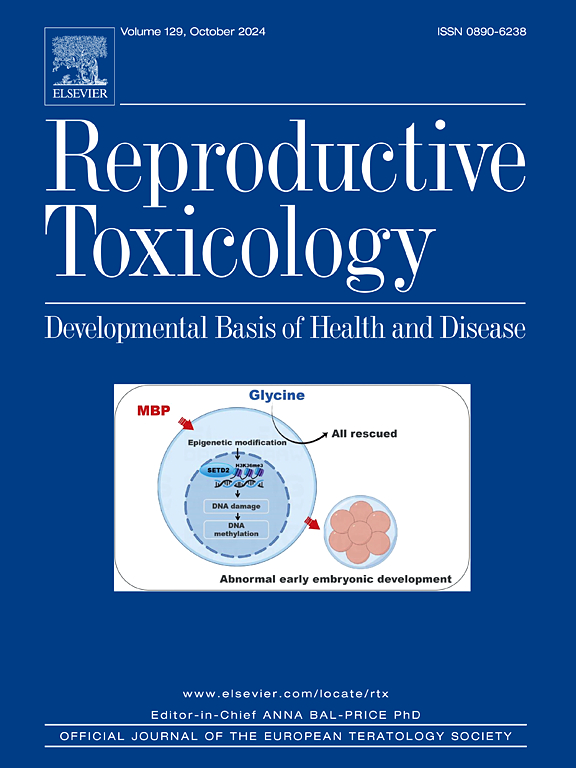Evaluating the safety profile of rosuvastatin in pregnant Wistar rats: Bridging gaps in reproductive safety data
IF 3.3
4区 医学
Q2 REPRODUCTIVE BIOLOGY
引用次数: 0
Abstract
Rosuvastatin, a statin used to treat hypercholesterolemia, inhibits the enzyme 3-hydroxy-3-methylglutaryl coenzyme A reductase (HGM-CoA reductase), reducing cholesterol synthesis. Beyond its lipid-lowering effects, rosuvastatin has pleiotropic effects, such as anti-inflammatory and antioxidant properties, with potential application in pre-eclampsia treatment. However, its safety during pregnancy remains controversial. This study evaluated whether prenatal treatment with rosuvastatin calcium induces maternal toxicity and possible embryotoxic, fetotoxic, and teratogenic effects in Wistar rats. Pregnant females received 10, 20, or 40 mg/kg/day of rosuvastatin or a vehicle (saline) by gavage from gestational day 0–20. Maternal toxicity was assessed through weight gain, food and water intake, biochemical markers, histopathology, and myenteric plexus neuron analysis. Fetal evaluations included external, visceral, and skeletal analyses. No significant differences were observed between groups in maternal weight gain, food and water intake, or biochemical parameters. Histopathological analysis showed no dose-dependent abnormalities in the liver, kidneys, heart, or uterus. Enteric neurons exhibited atrophy of nitrergic neurons at 10 and 40 mg/kg, while hypertrophy of total neuronal soma area was observed at 20 mg/kg. Cholinergic neurons were unaffected. Fetal evaluations revealed no significant external, visceral, or skeletal abnormalities attributable to rosuvastatin exposure. These findings suggest that rosuvastatin induces selective vulnerability of nitrergic neurons involved in nitric oxide-mediated adaptations to physiological changes during gestation, likely influenced by the tested exposure levels. Although no maternal or fetal toxicity was observed, alterations in the enteric nervous system underscore the need for further studies to investigate the underlying mechanisms and their potential implications for reproductive health.
评估瑞舒伐他汀在妊娠Wistar大鼠中的安全性:弥合生殖安全数据的差距
瑞舒伐他汀,一种用于治疗高胆固醇血症的他汀类药物,抑制3-羟基-3-甲基戊二酰辅酶a还原酶(HGM-CoA还原酶),减少胆固醇合成。除了降脂作用外,瑞舒伐他汀还具有多种作用,如抗炎和抗氧化特性,在子痫前期治疗中具有潜在的应用前景。然而,它在怀孕期间的安全性仍然存在争议。本研究评估了瑞舒伐他汀钙产前治疗是否会对Wistar大鼠产生母体毒性以及可能的胚胎毒性、胎儿毒性和致畸作用。妊娠女性从妊娠第0-20天开始,通过灌胃给予10、20或40 mg/kg/天瑞舒伐他汀或载药(生理盐水)。通过体重增加、食物和水的摄入量、生化指标、组织病理学和肌丛神经元分析来评估母体毒性。胎儿评估包括外部、内脏和骨骼分析。各组之间在母亲体重增加、食物和水的摄入量或生化参数方面没有观察到显著差异。组织病理学分析显示肝脏、肾脏、心脏或子宫无剂量依赖性异常。在10和40 mg/kg剂量下,肠道神经元表现为氮能神经元萎缩,而在20 mg/kg剂量下,神经元总胞面积肥大。胆碱能神经元未受影响。胎儿评估显示没有明显的外部、内脏或骨骼异常可归因于瑞舒伐他汀暴露。这些发现表明瑞舒伐他汀诱导参与妊娠期间一氧化氮介导的生理变化适应的氮能神经元的选择性脆弱性,可能受到测试暴露水平的影响。虽然没有观察到母体或胎儿毒性,但肠道神经系统的改变强调需要进一步研究其潜在机制及其对生殖健康的潜在影响。
本文章由计算机程序翻译,如有差异,请以英文原文为准。
求助全文
约1分钟内获得全文
求助全文
来源期刊

Reproductive toxicology
生物-毒理学
CiteScore
6.50
自引率
3.00%
发文量
131
审稿时长
45 days
期刊介绍:
Drawing from a large number of disciplines, Reproductive Toxicology publishes timely, original research on the influence of chemical and physical agents on reproduction. Written by and for obstetricians, pediatricians, embryologists, teratologists, geneticists, toxicologists, andrologists, and others interested in detecting potential reproductive hazards, the journal is a forum for communication among researchers and practitioners. Articles focus on the application of in vitro, animal and clinical research to the practice of clinical medicine.
All aspects of reproduction are within the scope of Reproductive Toxicology, including the formation and maturation of male and female gametes, sexual function, the events surrounding the fusion of gametes and the development of the fertilized ovum, nourishment and transport of the conceptus within the genital tract, implantation, embryogenesis, intrauterine growth, placentation and placental function, parturition, lactation and neonatal survival. Adverse reproductive effects in males will be considered as significant as adverse effects occurring in females. To provide a balanced presentation of approaches, equal emphasis will be given to clinical and animal or in vitro work. Typical end points that will be studied by contributors include infertility, sexual dysfunction, spontaneous abortion, malformations, abnormal histogenesis, stillbirth, intrauterine growth retardation, prematurity, behavioral abnormalities, and perinatal mortality.
 求助内容:
求助内容: 应助结果提醒方式:
应助结果提醒方式:


